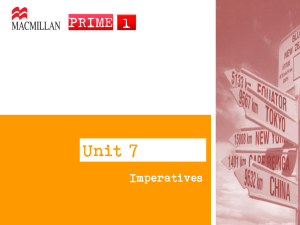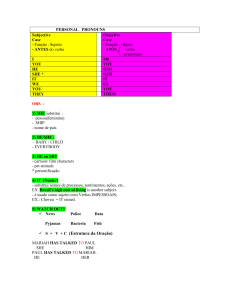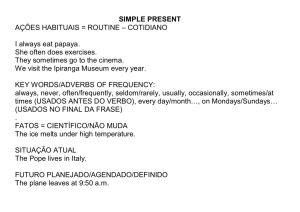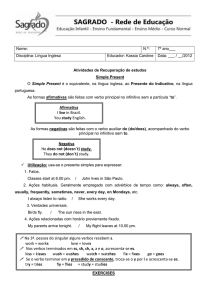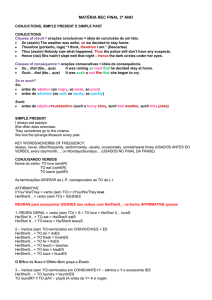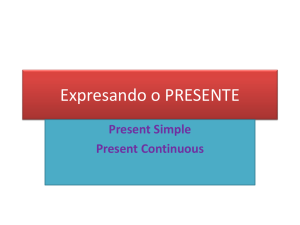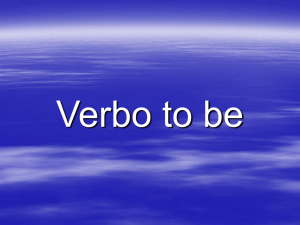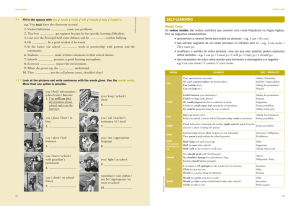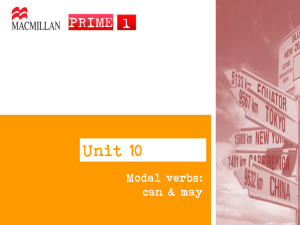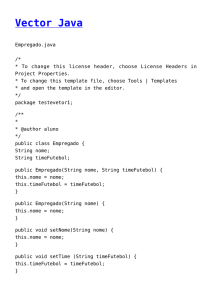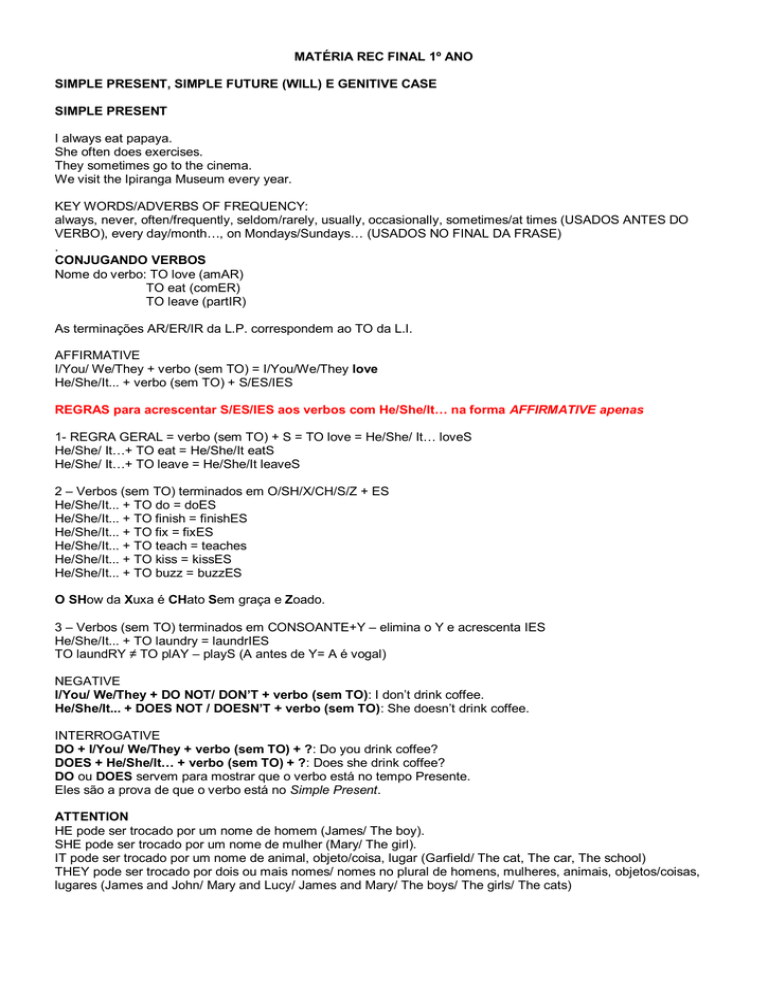
MATÉRIA REC FINAL 1º ANO
SIMPLE PRESENT, SIMPLE FUTURE (WILL) E GENITIVE CASE
SIMPLE PRESENT
I always eat papaya.
She often does exercises.
They sometimes go to the cinema.
We visit the Ipiranga Museum every year.
KEY WORDS/ADVERBS OF FREQUENCY:
always, never, often/frequently, seldom/rarely, usually, occasionally, sometimes/at times (USADOS ANTES DO
VERBO), every day/month…, on Mondays/Sundays… (USADOS NO FINAL DA FRASE)
.
CONJUGANDO VERBOS
Nome do verbo: TO love (amAR)
TO eat (comER)
TO leave (partIR)
As terminações AR/ER/IR da L.P. correspondem ao TO da L.I.
AFFIRMATIVE
I/You/ We/They + verbo (sem TO) = I/You/We/They love
He/She/It... + verbo (sem TO) + S/ES/IES
REGRAS para acrescentar S/ES/IES aos verbos com He/She/It… na forma AFFIRMATIVE apenas
1- REGRA GERAL = verbo (sem TO) + S = TO love = He/She/ It… loveS
He/She/ It…+ TO eat = He/She/It eatS
He/She/ It…+ TO leave = He/She/It leaveS
2 – Verbos (sem TO) terminados em O/SH/X/CH/S/Z + ES
He/She/It... + TO do = doES
He/She/It... + TO finish = finishES
He/She/It... + TO fix = fixES
He/She/It... + TO teach = teaches
He/She/It... + TO kiss = kissES
He/She/It... + TO buzz = buzzES
O SHow da Xuxa é CHato Sem graça e Zoado.
3 – Verbos (sem TO) terminados em CONSOANTE+Y – elimina o Y e acrescenta IES
He/She/It... + TO laundry = laundrIES
TO laundRY ≠ TO plAY – playS (A antes de Y= A é vogal)
NEGATIVE
I/You/ We/They + DO NOT/ DON’T + verbo (sem TO): I don’t drink coffee.
He/She/It... + DOES NOT / DOESN’T + verbo (sem TO): She doesn’t drink coffee.
INTERROGATIVE
DO + I/You/ We/They + verbo (sem TO) + ?: Do you drink coffee?
DOES + He/She/It… + verbo (sem TO) + ?: Does she drink coffee?
DO ou DOES servem para mostrar que o verbo está no tempo Presente.
Eles são a prova de que o verbo está no Simple Present.
ATTENTION
HE pode ser trocado por um nome de homem (James/ The boy).
SHE pode ser trocado por um nome de mulher (Mary/ The girl).
IT pode ser trocado por um nome de animal, objeto/coisa, lugar (Garfield/ The cat, The car, The school)
THEY pode ser trocado por dois ou mais nomes/ nomes no plural de homens, mulheres, animais, objetos/coisas,
lugares (James and John/ Mary and Lucy/ James and Mary/ The boys/ The girls/ The cats)
SIMPLE FUTURE (WILL)
EXPECTATIVA/ESPERANÇA
They will go to Belo Horizonte in January.
She will not fail in her exams.
PROMESSA
I swear I will never be hungy again.
Politicians promise thing that they won’t do.
PEDIDO
Will you marry me?
Will we have our money back?
FATO FUTURO: incertos (sem garantia)
The plain will take off at 8:30.
You will arrive in Maceió by 11 o’clock.
FÓRMULAS
AFFIRMATIVE
Sujeito + will + verbo (sem “to”)
NEGATIVE
Sujeito + will + not + verbo (sem “to”)
Sujeito + won’t + verbo (sem “to”)
INTERROGATIVE
Will + sujeito + verbo (sem “to”) + ?
OBSERVAÇÃO: SIMPLE FUTURE (WILL) corresponde ao FUTURO DO PRESENTE na Língua Portuguesa.
SIMPLE FUTURE
FUTURO DO PRESENTE
I will travel.
Eu viajarei.
You will travel.
Você viajará.
He will travel.
Ele viajará.
She will travel.
Ela viajará.
It will travel.
Ele / Ela viajará.
We will travel.
Nós viajaremos.
You will travel.
Vocês viajarão.
They will travel.
Eles / Elas viajarão.
GENITIVE CASE
É um modo mais formal de dizer que algo pertence a alguém/outro algo, ou seja, é a relação possuidor-coisa
possuída.
Basta substituir o of (de/do/da/dos/das) pelo ′ (apostrofo) ou ′s.
1. REGRA GERAL: possuidor no singular
The milk
of
the baby
The baby
′s
milk
2. POSSUIDOR NO PLURAL TERMINADO COM “S”.
The car
of
her parents
′
car
The curiosity
of
the people
The people
′s
curiosity
Her parentes
3. POSSUIDOR PLURAL SEM “S” NO FINAL.
4. NOME (DE PESSOA NÃO “FAMOSA”) TERMINADO EM “S”.
The letter
of
Thomas.
Thomas
′
letter.
5. NOME (DE PESSOA “FAMOSA”) TERMINADO EM “S”.
The plays
of
Sophocles.
Sophocles
′s
plays.
6. DOIS POSSUIDORES DE UMA MESMA COISA.
The cartoon
of
Tom and Jerry
′s
Tom and Jerry.
cartoon.
7. DOIS POSSUIDORES DE DUAS COISAS DIFERENTES.
The movies
of
Spielberg and Copolla.
Spielberg’s and Copolla’s
movies.
8. As palavras house, shop, cathedral, restaurant e church como coisas possuídas, são substituídas por
′S.
The restaurant
of
Fasano.
Fasano
′s
9. POSSUIDOR “COISA/OBJETO” (SER INANIMADO): não se usa NADA no lugar do of.
The story
of
toy.
Toy
story.

